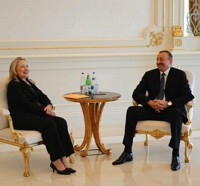With U.S. Secretary of State Hillary Clinton on a tour of the South Caucasus last week, hopes that Washington’s top diplomat could use the visit as an opportunity to push for regional peacemaking and democracy support were quickly overcome by events on the ground, underscoring the region’s volatility. Though Clinton’s meetings in Georgia were mostly low key, the brittle cease-fire between arch-nemeses Azerbaijan and Armenia was sorely tested by a series of clashes, fueling fears that another Caucasus war was in the offing.
Relations between Azerbaijan and Armenia have been rocky since the two former Soviet republics fought a war in the early 1990s over the disputed territory of Nargorno-Karabakh, a region largely settled by ethnic Armenians that is internationally recognized as part of Azerbaijan. When large-scale fighting ended in 1994, Armenian forces -- with assistance from geopolitical patron Russia -- had driven out Azerbaijani troops as well as ethnic Azeri communities from the province. Since then, Armenia has supported the unrecognized, separatist quasi-statelet of Nagorno-Karabakh, and international efforts to peaceably resolve the conflict have fallen short, leading to frequent descriptions of the dispute as a “frozen conflict.”
The conflict has been anything but frozen on the ground, however, and the dispute remains at constant risk of spiraling out of control. Though clashes are not uncommon along the line of contact, as the unofficial border between Nagorno-Karabakh and Azerbaijan is known, last week’s fighting had all the appearances of a series of escalations cascading out of control. Notably, skirmishes not only took place along the line of contact, but also at the borders of Armenia and Azerbaijan proper, a development that raised fears of the conflict heating up.

